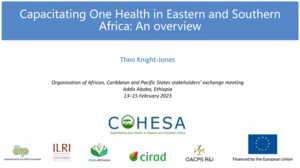
A trans-disciplinary study on the health risks of cryptosporidiosis from dairy systems in Dagoretti, Nairobi, Kenya: Study background and farming system characteristics
Abstract
This paper characterises the dairy farming system in Dagoretti, Nairobi. Characterisation was part of a broader ecohealth project to estimate the prevalence and risk of cryptosporidiosis and develop risk mitigation strategies. In the project a trans-disciplinary team addressed epidemiological, socioeconomic, environmental and policy aspects of cryptosporidiosis, an emerging zoonosis. This paper also provides background and describes sampling methods for the wider project. Three hundred dairy households were probabilistically sampled from a sampling frame of all dairy households in five of the six locations of Dagoretti, one of the eight districts of Nairobi Province. Randomly selected households identified 100 non-dairy-keeping households who also took part in the study. A household questionnaire was developed, pre-tested and administered in the dry and wet seasons of 2006. An additional study on livelihood and economic benefits of dairying took place with 100 dairy farmers randomly selected from the 300 farms (as well as 40 non-dairy neighbours as a control group), and a risk-targeted survey of environmental contamination with Cryptosporidium was conducted with 20 farmers randomly selected from the 29 farmers in the wider survey who were considered at high risk because of farming system. We found that around 1 in 80 urban households kept dairy cattle with an average of three cattle per household. Cross-breeds of exotic and local cattle predominate. Heads of dairy-keeping households were significantly less educated than the heads of non-dairy neighbours, had lived in Dagoretti for significantly longer and had significantly larger households. There was a high turnover of 10 % of the cattle population in the 3-month period of the study. Cattle were zero grazed, but productivity parameters were sub-optimal as were hygiene and husbandry practices. In conclusion, dairy keeping is a minor activity in urban Nairobi but important to households involved and their community. Ecohealth approaches are well suited to tackling the complex problem of assessing and managing emerging zoonoses in urban settings.
Citation
Kang'ethe, E.K., Kimani, V.N., McDermott, B., Grace, D., Lang'at, A.K., Kiragu, M.W., Karanja, N., Njehu, A.N., Randolph, T., Mbugua, G., Irungu, T.W. and Ombutu, P. 2012. A trans-disciplinary study on the health risks of cryptosporidiosis from dairy systems in Dagoretti, Nairobi, Kenya: Study background and farming system characteristics. Tropical Animal Health and Production 44(Suppl 1): S3-S10.










